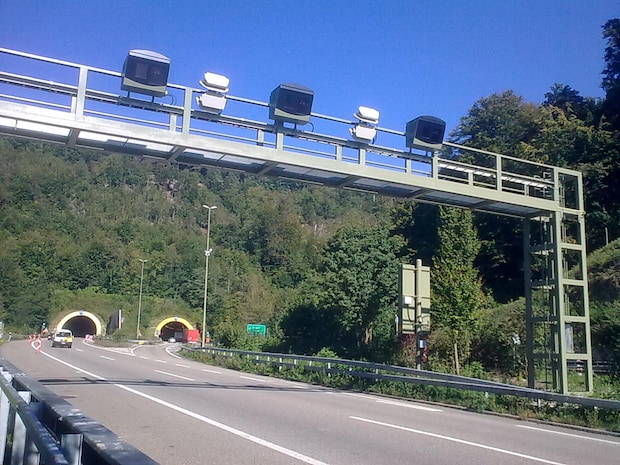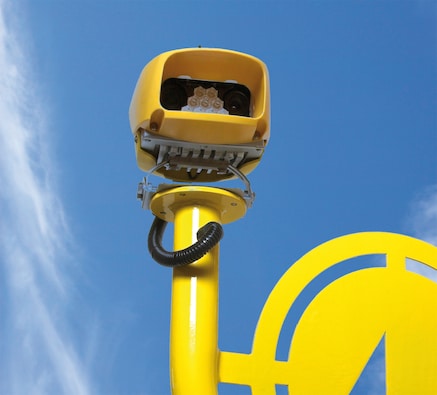- Mobility
Average speed cameras for section control – a new era in traffic monitoring
Speed control with a different approach: Section speed control is an alternative method of monitoring speed limits in road traffic that is currently being used increasingly frequently around the world. Instead of measuring the speed at a specific point, as is the case with fixed speed measurement, the approach is to measure the average speed of a vehicle over a much longer section of road. The benefits are obvious and proven: better compliance with speed limits over longer road stretches, fewer accidents, harmonized traffic flow, less congestion and reduced emissions, thus more eco-friendly traffic.
, Stefanie StäglinHow do average speed cameras work?
Depending on the country of use and its specific legal prerequisites, different technical solutions are available and in use. In general, section speed control is based on capturing a vehicle at both an entry and an exit point, each equipped with cameras for automatic number/license plate recognition (ANPR/ALPR). Each vehicle is recognized at both the first and second checkpoint, and the vehicle is matched by its license plate number using ALPR. In many countries, immediately after registration is read, the license plates are encrypted and anonymized by the system so as not to allow any conclusions to be drawn about the actual vehicle for data protection reasons. This means that when a vehicle is registered again at the end of the measurement section, the section speed control system matches the vehicle with the encrypted, anonymized data record from the entry point.

The system then calculates the average speed from the known distance between entry and exit and the time taken for each vehicle to pass. These values can be compared with the time a vehicle should take driving at the limit allowed. It does not log the maximum speed reached in the section – such as short speed peaks during an overtaking maneuver – but the average speed along the link overall. This approach is actually much simpler to understand and results in fewer technical challenges; it is simply a measure for how long it took to travel from A to B.
If the calculated speed exceeds the legal speed limit, potentially with an allowed threshold, the data is automatically forwarded to the camera shortly after the end of the monitored section. The camera then flashes and an image of the vehicle travelling too fast is recorded – and in Germany even as an image of the driver in the vehicle because this specific detail is needed to prosecute the speeding violation in Germany. In other countries where owner liability applies for example, the driver image can be dispensed with, so in these cases the data sets from the entry and exit points are sufficient. All lanes in the measurement section are monitored, therefore lane changes within the section are irrelevant for the speed measurement.
Scotland: Proven success in Europe’s largest speed enforcement system with average speed cameras
In Germany, this measuring method is still quite new, but has already proven itself in many countries. Scotland, for example, has made use of the technology on a variety of roads and in different regions. More than 350 kilometers (220 miles) of Scottish roads have been equipped with Jenoptik’s SPECS average speed camera systems. These many and varied sections clearly show that the benefits can be seen on all types of roadway, not just country roads or freeways. From Europe’s longest section speed control on the UK’s A9 – with a total length of around 220 kilometers (135 miles) – to urban systems as short as 400 meters (0,25 miles) in Glasgow, these installations have shown that driver behavior changes and improves greatly wherever section speed control is deployed, according to the findings of the trade press journal Traffic Technology Today.

A further example of the benefits of section speed control is the Scottish A90 freeway between the center and the northeast of Scotland. This 80 kilometer (50 miles) section of the A90 is used by an average of 23,000 vehicles every day and has always had high accident figures with many casualties in the past. The installation of average speed cameras was able to positively influence driver behavior address the issues very efficiently and sustainably. The figures speak for themselves: the speed limit of 70 mph (approx. 112 km/h) is now adhered to by 99 percent of drivers over the entire stretch – in contrast to only 40 percent before the installation. Only one in 5,000 vehicles now drives more than 10 mph (16 km/h) over the speed limit – down from one in five before. This also reduces the number of accidents and injuries.
“This experience is by no means unique. A well-designed average speed enforcement system always makes for a safer road and thus fewer accidents and fewer casualties, with more than 200 UK routes currently benefitting from Jenoptik’s average speed camera solutions” says Geoff Collins, Sales and Marketing Director at Jenoptik Traffic Solutions UK.
Kuwait: More traffic safety with average speed cameras in an especially critical road situation
Another example is the recent installation on one of the longest sea bridges in the world – the “Sheikh Jaber Al-Ahmad” bridge in Kuwait. Since its inauguration in 2019, the bridge has connected the capital Kuwait City with the Subbiyah region in the north (Subbiyah link 36 kilometers or 22 miles) as well as with the suburb Doha (Doha link 12 kilometers or 7,5 miles). Jenoptik’s TraffiSection technology was installed for section speed control and has been in use since then, contributing to increased traffic safety in a road section that is especially difficult to access in case of any incident or accident.
For the sake of the environment: Average speed cameras for more sustainability and environmental protection
In addition, harmonization and reduction in speed can also reduce environmental emissions very efficiently. In Wales, for example, toxic emissions have been reduced by up to 47 percent and thus almost halved in this way on particularly polluted sections of the Welsh freeway system. A number of routes are benefiting from SPECS average speed cameras to control vehicle speeds, thus managing vehicle emissions. This is actively providing a contribution to better air, environmental protection and the health of every individual!
According to the European Environment Agency (EEA), a reduction in speed on European highways from 120 km/h to 110 km/h could already reduce the fuel consumption of passenger cars by 12 to 18 percent. The fuel consumption of passenger cars increases exponentially from around 80 km/h due to the increased air resistance and can be reduced accordingly with reduced speeds or speed limits.

Average speed cameras seen as a more acceptable form of control
Speed measurement with average speed cameras is perceived as fairer by road users because the speed is not measured at a specific point but over a longer distance. This means that it is not a single point where the speed limit is exceeded due to short-term inattention that is penalized, but rather misconduct that is maintained over a longer period of time. The fact that the section speed control is usually announced in advance with road signs and the driver's attention is drawn to traffic enforcement on that section means that accusations of “rip-offs” are reduced and motivation to comply with the regulations increases. In addition, the dangerous braking in the area of stationary or mobile speed controls is also eliminated, all of which helps to contribute to smoother, stable traffic flow and lower emissions.Flexibility through stationary and mobile average speed camera solutions, also for special road situations
The Jenoptik systems for section speed control are based on a modularly structured system, allowing a huge range of road types to be controlled. They are designed to be suitable both for stationary, longer-term use, for example in tunnels or at accident blackspots, and for mobile, temporary use, such as in construction site areas. For temporary monitoring of construction site areas, for example, the average speed camera system can be moved as construction progresses, using techniques and structures that support the construction phase. As an example, this approach has been so successful in the UK that more than 450 works zones have operated with SPECS cameras, during contracts from 6 weeks through to 4 years long, covering sites from 500m to 54km in length!
On request, the basic system can also be supplemented with customer-specific modules such as connection to an existing variable message sign system (VMS), classification of different vehicle classes, wrong-way driver detection or detection of hazardous goods transporters. Even complex traffic flows with intersections and junctions can be covered by combining several road sections into one overall system – a so-called multi-section system.
Average speed cameras soon throughout Germany?
The use of Germany’s first section speed control installation was prepared and tested for a long time in a pilot project in the federal state of Lower Saxony. This did not only involve the technical approval of the measuring system by the Physikalisch-Technische Bundesanstalt (PTB, the German metrology authority), but also requirements with regard to data protection, an especially critical issue in Germany. All relevant authorities approved section speed control, and in September 2020 the Federal Administrative Court also confirmed: Jenoptik’s section speed control system in Lower Saxony is legally in use.
First figures show impressive results: Accidents could be reduced by more than 40% compared to the years before the installation, casualties were reduced by 80% and injuries even by more than 80%. Jenoptik paved the way for introducing section speed control in Germany, so that average speed cameras can from now on be legally used for traffic enforcement in Germany.
Given the benefits of section speed control, this type of speed enforcement will increasingly make its way onto our roads in the years to come, leading to improved traffic safety with fewer accidents, to better traffic flow with less congestion and better air quality through reduced emissions.
Product Recommendations
About Stefanie Stäglin
Stefanie Stäglin has been Head of Communications and Marketing at Jenoptik Light & Safety since 2014. A humanities graduate with an additional MBA, she previously worked for several years in the communications and automotive industries and enjoys traveling the world in her spare time.








